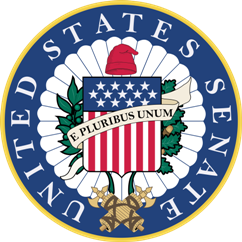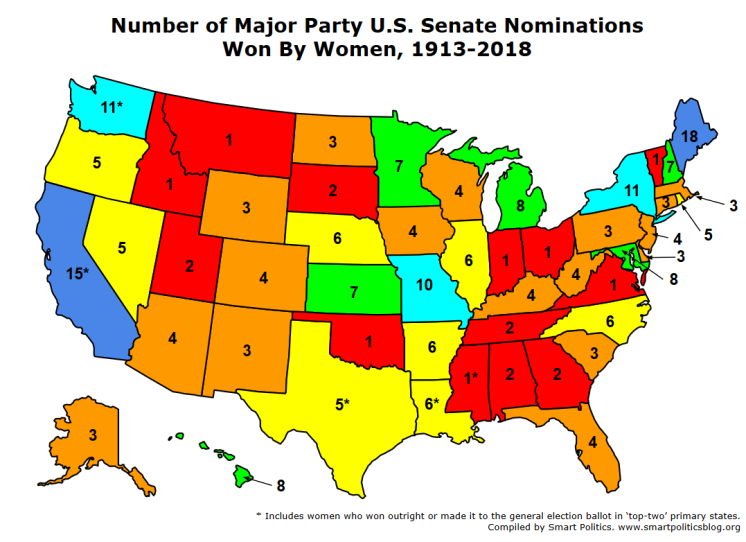Which States Have Had the Most Women Nominated to the US Senate?
Major parties in nine states have not nominated a woman to the U.S. Senate this century

And, as a recent Smart Politics report noted last week, it may prove difficult in 2020 to equal or best the record 23 Democratic and Republican women who received U.S. Senate nominations last cycle.
Due in part to Republicans defending 22 of 34 seats in 2020, there will be far fewer women running to defend their seats next year (seven) compared to 2018 (13).
One of those women, GOPer Cindy Hyde-Smith, helped get Mississippi off the schneid in 2018 as it became the last state to see a woman who identified with a major political party make it to the general election ballot. [Note: Though Hyde-Smith was technically not a Republican nominee in Mississippi’s 2018 non-partisan special election; the race resulted in a top-two runoff with Democrat Mike Espy, as no candidate received a majority of the vote on November 6th].
Eight other states have also done so only once: Idaho (Gracie Pfost, 1962), Virginia (Edie Harrison, 1984), Indiana (Jill Long, 1986), Vermont (Jan Backus, 1994), Ohio (Mary Boyle, 1998), Montana (Amanda Curtis, 2014), and Oklahoma (Connie Johnson, 2014).
Five other states have had major parties nominate women to the office just twice: South Dakota, Alabama, Georgia, Tennessee, and Utah.
In addition to Hyde-Smith, the other women in the U.S. Senate scheduled to defend their seats in 2020 are Republicans Martha McSally of Arizona, Joni Ernst of Iowa, Susan Collins of Maine, and Shelly Moore Capito of West Virginia plus Democrats Tina Smith of Minnesota and Jeanne Shaheen of New Hampshire.
It is a bit early to predict how many other women will emerge as nominees by next year, although the door seemingly swung open for Congresswoman Liz Cheney of Wyoming to graduate to the upper legislative chamber, with Senator Mike Enzi’s retirement announcement last weekend.
Other possible nominees include three Democrats: former Columbus Mayor Teresa Tomlinson of Georgia, New Mexico Secretary of State Maggie Toulouse Oliver, and North Carolina state Senator Erica Smith.
Over the decades, the state with the largest number of women to receive major party U.S. Senate nominations is Maine with 18; Senator Collins hopes to add to that total next year.
California has produced 15 such nominees followed by New York and Washington with 11 each, Missouri with 10, and Hawaii, Maryland, and Michigan with eight.
Democrats and Republicans in nine states have yet to nominate a woman to the U.S. Senate this century: Idaho (Gracie Pfost, 1962), Virginia (Edie Harrison, 1984), Indiana (Jill Long, 1986), New Jersey (Christine Todd Whitman, 1990), South Dakota (Charlene Haar, 1992), Vermont (Jan Backus, 1994), Rhode Island (Nancy Mayer, 1996), Colorado (Dottie Lamb, 1998), and Ohio (Mary Boyle, 1998).
Four additional states did not do so during the 2010s: Wyoming (Joyce Jansa Corcoran, 2002), Florida (Katherine Harris, 2006), Texas (Kay Bailey Hutchison, 2006), and Alabama (Vivian Figures, 2008).
In total, women have been nominated by major parties to the U.S. Senate 237 times during the direct election era.
Follow Smart Politics on Twitter.


1. “…Mississippi…the ‘last’ (most recent) state to have a woman nominated…” The Magnolia State is still ‘on the schneid’ (to use a US sports slang); the ’18 election was a nonpartisan top-two special general election, in which, absent an outright majority by one candidate, the 2 candidates with highest # of votes without regard to party would advance to the runoff. Ex-D Hyde-Smith would have to (again) defeat perennial US Senate aspirant Chris McDaniel next year in order to have Female Nominee of Major Party on her resume.
2. I for one can not think of any AL US representative from WY losing a bid for the US Senate nomination (general elections have historically been more problematic; only in 1994 and 1960 has the lone House member gone on to win, and one of those died prior to being sworn in). If “Liz” decides to “graduate” to the Other Body, it may mean that she believes the Ds will be in control of the chamber for the forseeable future.
RE #1. Very true, good catch, and thus worthy of an updated note of clarification (above) to expand the definition herein to capture ‘women identified with a major political party to appear on the general election ballot.’ I believe Sen. Hyde-Smith is the only one of the 237 examples to require such a disclaimer.
3. “…237 times…” Quite a bit FEWER, if one were to adhere to the (strict) definition of official party nominations. Namely, a handful of states have adopted “top-2” blanket/jungle initial (winnowing) contests instead of party primaries (LA since 1978 Senate elections; WA since 2010; CA since 2012). Thus, neither major state party ‘nominated’ any females (or males, for that matter) during the pertinent periods (e.g. P L “Patty” Murray was the nominee for her party in 1992, 1998, and 2004, but not thereafter; Mary Landrieu was never nominated by her party, even though she served for 3 terms). Other recent cases are the CA 2018, in a case with a long-serving incumbent losing the official endorsement of her state party despite finishing about 32% ahead of her main challenger in the initial balloting (the national party, led by the former and future House speaker and the most recent ex-POTUS, stood by “DiFi”, and she remained “identified with” her party, endorsement or no); the AK 2010, with a write-in incumbent prevailing over the official Xy party nominee; and the TX 1993 special, with three prominent Rs making the bid under “top-2” (same as MS 2018 special).
Absolutely (and now more clearly noted in the figure). As you suggest, Murkowski 2010 cannot be counted under any loose definition of the term as she did not appear on the general election ballot.